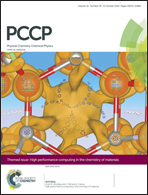Structure, fragmentation patterns, and magnetic properties of small cobalt oxide clusters
Abstract
The favorable stoichiometry of ConOm+ clusters has been recently determined by means of multiphoton dissociation of oxide cluster beams coming from laser evaporation of metal rods seeded with 0.5–5% oxygen and selected by time of flight mass spectroscopy. It was observed that the prominent stoichiometry is n = m, and that the preferred dissociation channel is the loss of O2 molecules. The Co4O4+ cluster is found to be particularly abundant, an indication of its high stability. In this work we present density functional calculations, within the generalized gradient approximation, for the geometric, electronic, and magnetic properties of neutral and cationic ConOm0/+ clusters with n = 3–8 and m = 1–10. The ionic structures were determined after optimizing several initial geometries selected from previous calculations of pure Co clusters, with consecutive adsorbed oxygen atoms, as well as geometries constructed by assembling several CoO units and adding subsequent oxygen atoms. The fragmentation patterns were studied by comparing the energy separation of O2, CoO, Co2O, CoO2, and Co fragments. We obtain that the preferred fragmentation channel is the loss of O2, that the favourable stoichiometry is 1 : 1, and that Co4O4+ is especially stable, in full agreement with the experiments. In addition the magnetic properties related to spin isomeric configurations of (CoO)n+ clusters are studied in detail.


 Please wait while we load your content...
Please wait while we load your content...